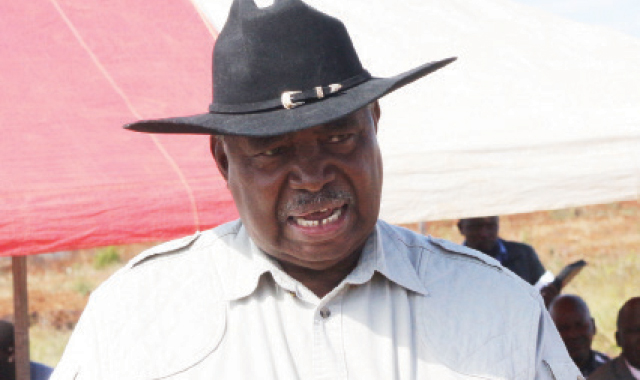Hunger reverses gains of TB fight

Thandeka Moyo
IT took Nkosilathi Mlambo* about 18 months to recover from the deadly drug resistant tuberculosis (DR-TB) which threatened to render his body useless.
He remembers his first dreaded trip to Thorngrove Hospital in Bulawayo after health officials confirmed that his body was now fighting a drug resistant strain of TB whose prevalence has risen in the past few years in Zimbabwe.
The Centre for Disease Control and Prevention (CDC) defines DR-TB as caused by a bacterium (Mycobacterium tuberculosis) that has developed a genetic mutation which resists drugs normally used to treat TB.
Mr Mlambo said he defaulted due to hunger as taking tablets without enough food was stressful.
He said nurses at the institution however assured him that if he adhered to clinical recommendations he would recover and lead a healthy lifestyle again.
“I was diagnosed with TB in 2013 and since my system was stronger then, nurses gave me tablets and warned against defaulting. Back home in Nkayi, I failed to adhere as I was forced to survive with just one light meal per day,” said Mr Mlambo.
“After a year, I had lost count of the number of days I didn’t take my medication and I convinced myself I would be okay,” he said.
Mr Mlambo said he is happy he got DR-TB medication which costs about $2,571 per person courtesy of the Government as he was never going to afford the treatment.
“I was a lucky patient as I heard a few failed to get medication at one point. I’m now working very hard to provide healthy food for my family so I don’t relapse, I can’t imagine taking that medication again in my life.”
A nurse working at the hospital who spoke on condition of anonymity said most patients defaulted because of food shortages and lack of moral support.
“Most medication is procured by the Government though there are delays in disbursement. We continue to treat more people who default their first line medication and claim to not have access to food which is a necessity for anyone undergoing any type of TB medication.”
Bulawayo City Council (BCC) senior public relations officer Mrs Nesisa Mpofu said the city registered about 139 patients suffering from DR-TB in 2014 and 2015. Nine of the patients died at its health centres.
Mrs Mpofu said treatment of DR-TB takes about two years which has resulted in some patients defaulting once they get better.
“DR-TB takes 24 months to treat and it is vital for patients suffering from this condition to get support from their family or relatives to ensure they take treatment as prescribed,” she said.
Mrs Mpofu said the municipality run hospital situated in Thorngrove used to administer all DR-TB patients before the decentralisation of the process.
“Initially, all DR-TB patients from the southern region were admitted to Thorngrove Hospital and there were delays in diagnosis. DR-TB was later decentralised and Bulawayo took care of its own patients. The challenge now is that more patients are getting sicker and there are more deaths in diagnosed patients. Outcomes for 2014 and 2015 are not included as they are still under treatment.”
“Some of the patients are still undergoing treatment and most of them are outpatients receiving treatment at their local municipal clinics.”
Mrs Mpofu said residents who look after TB patients should ensure that they practise cough hygiene and ensure that their homes are well ventilated.
She said relatives of those suffering from DR-TB and close contacts need to cooperate with health workers by coming forward for TB screening and support their loved ones.
Statistics from the Ministry of Health and Child Care revealed that of the 1,580 cases of DR-TB that were recorded in 2015, the Government sourced medication for 1,371 patients.
“The number of DR-TB detected cases were at 40 in 2010 and we only availed medication to 28 people. The statistics have risen over the past years to 1,580 and we are still working on providing medication for all our patients diagnosed with DR-TB,” reads the Ministry’s report.
According to the report, the country is conducting a national drug resistant survey to determine the burden of DR-TB in different provinces.
“Data collection for this will be conducted in August 2016. The last such survey was conducted in 1994/95 that put the burden of DR-TB at 1,9 percent and 8,3 percent among new smear positive TB cases and smear positive retreatments, respectively,” states the report.
“Between 2002 and 2010, it was not possible to prescribe second-line anti-TB drugs because they could not be procured, due to financial constraints.”
The Ministry also made arrangements through the World Health Organisation Green Light Committee to procure and supply second-line anti-TB drugs.
“Programmatic Management of Drug Resistant TB (PMDT) in Zimbabwe was re-initiated in 2010 with the establishment of two multi-disciplinary regional centres that is, Northern (Harare) and Southern (Bulawayo). Since the re-initiation of PMDT in Zimbabwe in 2010, continuous training efforts have been conducted.”
Dr Ruth Labode, who chairs the Parliamentary Portfolio Committee on Health said budgetary constraints affect adequate allocations to the Ministry which hinders its performance in combating TB in Zimbabwe.
“Despite the critical need for increased TB resources, donor funding for TB decreased by nearly 10 percent in 2014. There is need to improve domestic TB financing initiatives to avert the risk of foreign funding drying up. The National Aids Council (NAC) should also set aside a defined proportion for TB activities and financing,” said Dr Labode.
She urged the Government to reduce the exorbitant cost of second line TB treatment.
“TB has become more dangerous than HIV because with HIV if you go on anti-retroviral treatment, you can be treated and we are getting to zero but with TB we are not getting to zero.”
Dr Labode said infrastructure remains a challenge as the country relies on laboratories constructed before independence which do not conform to current international standards.
A total of 515 healthcare workers have been trained in and outside of the country courtesy of The Union, TB CARE I, World Health Organisation and Médecins Sans Frontières (MSF).
Thorngrove Hospital is located along Candelabra Road in Thorngrove and was established in 1941 as an infectious diseases hospital.
The hospital has laboratory, kitchen, laundry and sewing departments with a staff complement of 70.
BCC, which runs the hospital, has recorded a 60 percent success rate in curing DR-TB.
Globally, TB is the most common presenting illness and leading cause of death among people living with HIV including those who are taking anti-retroviral treatment. It accounts for one in five HIV related deaths.
People living with HIV face emerging threats of Multiple Drug Resistant-Tuberculosis (MDR-TB) and Extensively Drug Resistant-TB (XDR-TB).








Comments